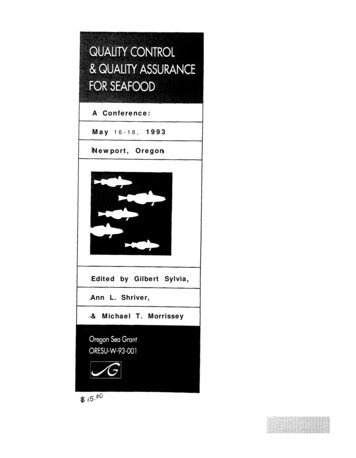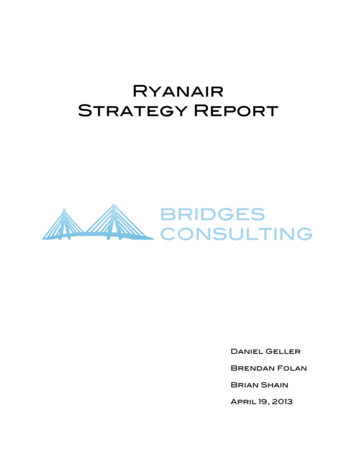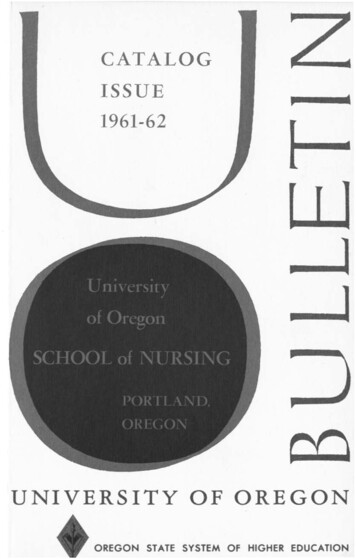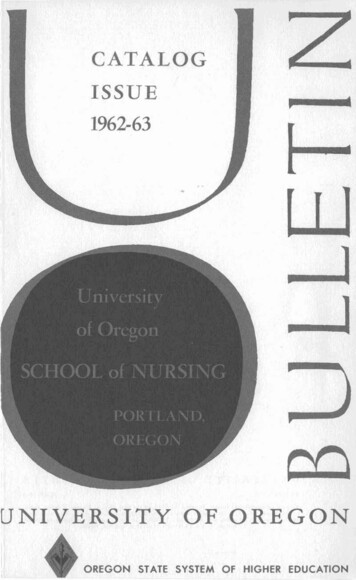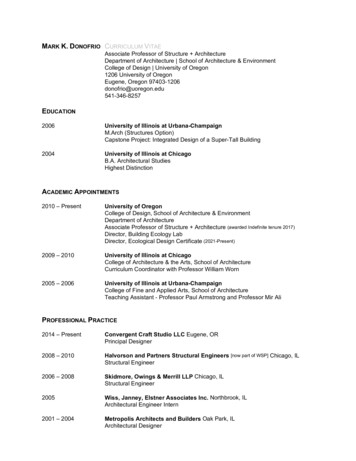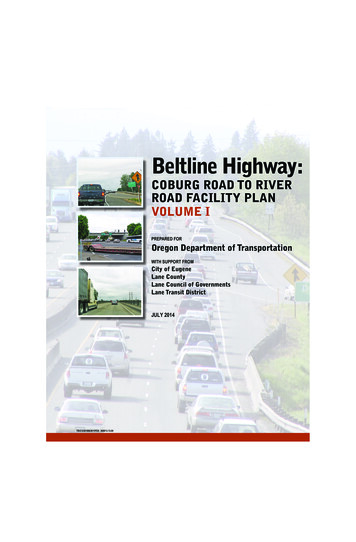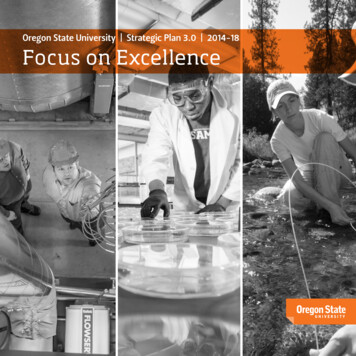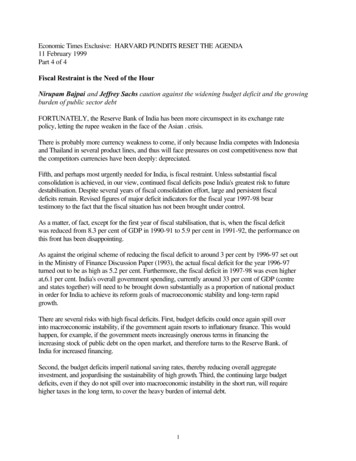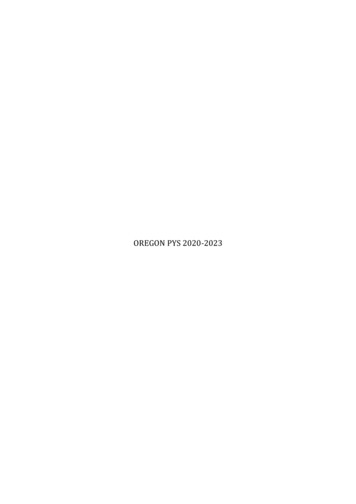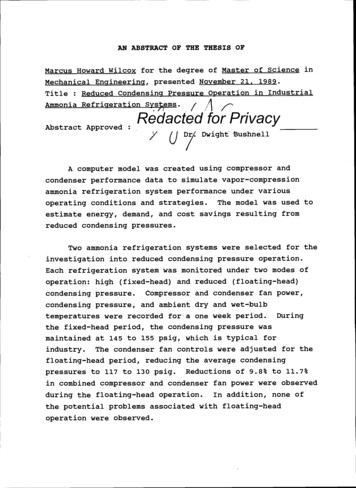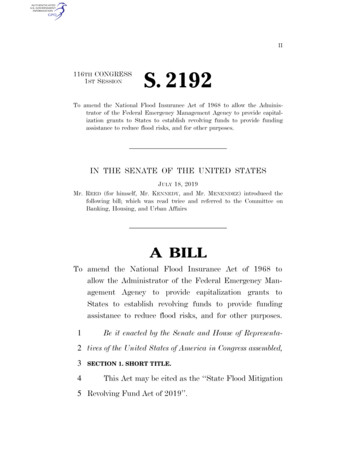
Transcription
O REG O N S TAT E U N I V ER SI T YFiscal Year 2011Greenhouse Gas InventoryGreg SmithSustainability Program AssistantBrandon TrelsadSustainability CoordinatorOSU Sustainability OfficeFacilities ServicesJan. 2012oregonstate.edu/sustainability/climate
ACKNOWLEDGEMENTS . 4DEFINITIONS OF KEY TERMS . 6EXECUTIVE SUMMARY . 9INTRODUCTION. .13METHODOLOGY .13BOUNDARIES .14FINDINGS AND ANALYSIS .16FUTURE ACTION .19FINDINGS TABLE .22GRAPHS AND DATA TABLES.30
AcknowledgmentsDue to the broad scope of this inventory, a large number of people from manydepartments, businesses and organizations were involved. We would like tothank them here.Oregon State UniversityAgriculture Experiment Stations: Valerie Lieuallen, Leta Morton,Shelley Hughes, Sue Hansell, Carol Cole, Arthel Ambrose, Kim Verhelst,Peggy Carr, Mary Mosier, Jan Jones, Debbie Burroughs, Jack Breen, TimDelCurto, Willie Riggs, Virginia CampbellAnimal Sciences: Nora RossBusiness Affairs: Julie Stratton, Bezunesh Abebe, Steve Nash, MargaretTaylorBusiness Services: Justin Fleming, Manuel Balesteri, Pete Lepre, GayleSmith, Keahi McFaddenOSU-Cascades Campus: Sandie Franklin, Kira BillingsleyExtension Service: Debby Maddy, Laura Frye, Cory Parsons, RickFletcher, Roxie Applebee, Glenn Ahrens, Vicky Krenz, Shirley Bower,Pam Wiederholt, Sheryl McDonald, Diana Martin, Laurie Miller, JudyJaeger, Sue Miller, Georgia Draper, Joanne Kiyokawa, Debbie Burroughs,Shawn Morford, Lyn Phelps, Bry Jasper, Robin White, RosemaryWeidman, Donna Culley, Donita Roseboro, Beth Emshoff, DarceeMitchell, Marita Broadus, Jim Hermes, Jenny Chavez, Glenda Hyde,Sandy Macnab, Jackie Russel, Randy Mills, Bonnie Roemer, JohnWilliams, Kim McCullough, Amy Derby, Debra ZavesonFacilities Services: Les Walton, Mac McGuire, Patty Katz, Fritz Wilhelm,Greg Riutzel, Mike SeversonHatfield Marine Science Center: Randy Walker, Joel Colvin, MaryannBozza, Chelle BoswellRadiation Center: Shirley CampbellShip Operations: Pete ZerrStudent Health Services: George VossUniversity Publications: Amy Charron4
Veterinary Medical Animal Isolation Lab: Lisa PlagmannBusinesses and ConsultantsAzumano Travel, Corvallis: Tony FuerteCarson Oil: Amber SamsEnterprise Rent-A-Car: Davion ReeseFirst Student: Brian MaxwellGood Company, Eugene: Joshua Skov, Aaron ToneysTeel’s Travel, Corvallis: Brad TeelGovernment OrganizationsBaker County: Jason YencopalBeaverton School District: Carolyn SloanBonneville Power Administration: Greg VassilloCurry County FairgroundsGrant County: Brenda PercyHarney County Courthouse: Lidene HeardJefferson County: Carol Olin5
Definitions of Key Terms(1) “Carbon dioxide” (CO2) means the chemical compound containing one atomof carbon and two atoms of oxygen.(2) “Carbon dioxide equivalent” (CO2e) represents the quantity of agreenhouse gas multiplied by a Global Warming Potential (GWP) factor, relativeto CO2. This is the “standard unit” used to quantify various greenhouse gasses.(3) “Global Warming Potential factor” (GWP) means the radiative forcingimpact of one mass-based unit of a given greenhouse gas relative to anequivalent unit of carbon dioxide over a given period of time. For instance,methane (CH4) has a GWP of 23, meaning that every gram of methane will trap23 times as much solar radiation as a gram of CO2.(4) “Radiative Forcing Index” (RFI) is a multiplier designed to account for theeffects on climate an emission source will cause in addition to the release offossil carbon. The RFI is most commonly used for aviation emissions, where itaccounts for the effects of releasing greenhouse gases at altitude. TheIntergovernmental Panel on Climate Change (IPCC) has estimated the RFImultiplier for aviation at 2.0-4.0.(5) “Greenhouse gas” (GHG) is any gas that contributes to anthropogenicglobal warming including, but not limited to, carbon dioxide, methane, nitrousoxide, hydrofluorocarbons, perfluorocarbons, and sulfur hexafluoride.(6) “Metric ton, tonne, or metric tonne” (t) means one metric tonne (1000kilograms) or 2204.62 pounds.(7) “Total emissions” is the calculated sum of GHGs emitted due to OSUrelated activities.(8) “Net emissions” is the calculated sum of GHGs emitted minus renewableenergy certificates, composting activities and carbon offsets.(9) “Renewable energy source” means any source of energy that isreplenished rapidly by natural processes. Renewable sources may include, butare not limited to, wind, solar, hydroelectric, biomass, geothermal, tidal or seacurrents etc.(10) “Statewides” refers to the inventory that analyzes emissions from statewide,legislatively-mandated OSU entities, specifically the Agricultural ExperimentStations (AES), Extension Service and the Forest Research Laboratory (FRL).6
(11) “Renewable Energy Certificate” (REC) is a tradable certificate thatrepresents a unit of energy produced by renewable energy sources. The ownerof a REC can claim that they are using renewable energy equal to the amount ofRECs owned.(12) “Bonneville Environmental Foundation (BEF)” is a Portland-based nonprofit which specializes in carbon offsets, mainly renewable energy certificates(RECs). These credits increase the volume of clean, renewable energy thatenters the electrical grid. OSU purchases RECs from BEF as part of the studentrenewable energy fee.(13) “Renewable energy fee” refers to the student-approved initiative that directs 8.50 per term per student towards the purchase of RECs. These RECs offset alarge percent of OSU‟s electrical consumption with additions of clean, renewableenergy to the electrical grid.(14) “World Business Council for Sustainable Development (WBCSD)” is aglobal association of business representatives that deals exclusively withbusiness and sustainable development.(15) “Greenhouse Gas Protocol (GHGP)” is an internationally-used accountingtool that allows business and governmental leaders to understand, quantify andmanage greenhouse gas emissions. It provides a framework for nearly everygreenhouse gas standard and program in the world. The WBCSD was anoriginal partner in drafting and creating the GHGP.(16) “Intergovernmental Panel on Climate Change (IPCC)” is a scientific bodyestablished to provide policymakers with an objective source of information onclimate change. The IPCC performs no research nor does it monitor climatedata; it instead offers analysis of research and climate data as an objective bodywith a broad range of views, expertise and wide geographical coverage.(17) “Clean Air-Cool Planet” (CA-CP) is a non-partisan, non-profit organizationthat aims to find and promote solutions to global climate change. Their carboncalculator is used by many campuses for calculating emissions.(18) “American College and University Presidents Climate Commitment”(ACUPCC) is an effort to encourage commitments from institutions of higherlearning to neutralize greenhouse gas emissions and prioritize the research andeducation efforts aimed at stabilizing earth‟s climate.7
Definition SourcesOregon Department of Environmental Quality: www.deq.state.or.usBonneville Environmental Foundation: www.greentagsusa.orgWorld Business Council for Sustainable Development: www.wbcsd.orgGreenhouse Gas Protocol: www.ghgprotocol.orgIntergovernmental Panel on Climate Change: www.ipcc.chClean Air-Cool Planet: http://www.cleanair-coolplanet.org/American College and University Presidents Climate org/8
Executive SummaryOregon State University (OSU) continues to demonstrate regional leadership andreceive national attention for sustainability-related activities and initiatives. Partof the basis for this recognition is OSU President Ed Ray‟s April 2007 signing ofthe American College and University Presidents Climate Commitment(ACUPCC). In part, the Climate Commitment requires inventorying greenhousegasses every two years (OSU performs them annually). This Fiscal Year 2011(FY11) OSU Greenhouse Gas (GHG) Inventory Report is an update andexpansion of the FY10, FY09, FY08 and FY07 OSU GHG inventories, whichthemselves are expansions of a CY04 inventory commissioned by the OregonUniversity System (OUS)The FY11 inventory provides:1.2.3.A snapshot of OSU emissions: quantified greenhouse gas emissionsresulting from OSU-related activities for the fiscal year ending June 30,2011Comparison with prior OSU inventories: a comparative analysis withFY07, FY08, FY09 and FY10 emissionsGuidance for future inventories: the methodology, successes, challengesand rationale of this expanded report provide a framework for future OSUreports.Findings in BriefTotal gross emissions of 143,532 metric tonnes (t) carbon dioxideequivalent (CO2e), a 5.3% decrease from FY10o This decrease was mainly due to electricity production at theEnergy Center, which generates electricity with fewer emissionsthan electricity purchased from the utility.Net emissions per full-time equivalent (FTE) student of 3.0 t CO2e, a48.4% decrease from FY10.Net emissions per 1000 square foot of 10.2 t CO2e, a 38.6% decreasefrom FY10.Net emissions of 71,876 t CO2e, a 36.6% decrease from FY10o This decrease was due primarily to a large purchase of renewableenergy certificates by OSU administration.9
Table 1 shows the total gross and net emissions by scope for the FY07,FY08, FY09, FY10 and FY11 inventories.Scope 1 emissions are mainly from fossil fuel combustion, refrigerants andagriculture; scope 2 emissions are from purchased electricity; scope 3emissions includes air travel, other university financed travel (personalmileage reimbursement, Athletics bus travel, etc.), commute, solid waste,and line losses due to the transmission and generation of electricity.OSU is only responsible for mitigation of emissions from scope 1 and 2, aswell as emissions from commute and air travel.Net emissions of 64,214 t CO2e that OSU is required to mitigate by theACUPCC.Gross emissions from operations in Corvallis represent 96.3% of totaluniversity emissions.10
Changes in net emissions from the major emissions sources are shown in theTable 2 below.Potentially significant emissions sources not included are:Long-distance student travel, including study abroad travelLifecycle/embodied emissionsTransportation and processing of materials to be recycledWater treatment and distributionSolid waste and fleet emissions for Statewides, HMSC and OSUCascadesSome OSU Athletics team travelChanges since the FY10 InventoryEmissions sources included for the first time in FY11 are:o Energy Center (full year of operation)o Non- Travel Reimbursement Entry System (TRES) reimbursedtravelEmissions sources with a significant change in emission calculationmethodology include:o Solid wastePlease see the Analysis of Data and Results section for more details regarding thesesources and improvements.11
12
IntroductionOregon State University‟s fourth annual comprehensive greenhouse gasinventory again reflects a continual improvement of data collection methods andanalyses. This report contains fewer changes relative to the previous annualreport issued for Fiscal Year 2010. Although not reflected in this shorter report,more than ever, constructing an inventory with this level of detail is amonumental task.In an effort to streamline the report format, the OSU Sustainability Office hasmoved to a reporting structure that highlights changes in methods from year toyear. Rather than include text that largely remains static, the authors will, whenappropriate, direct readers to past reports for specific details and references.As was the case for the FY10 report, the science and methods behind bestpractice inventory work is ever-evolving, making year-to-year comparisonscomplex. Greenhouse gas measurement is an increasingly important state andnational issue. OSU‟s inventory processes exceeds with a comfortable marginthe strictest regulatory requirements. Feedback is appreciated on this documentand the processes used to create it. Please visithttp://oregonstate.edu/sustainability/climate for details and updates.MethodologyOverviewWith operations as broad and far-reaching as Oregon State University‟s, thelargest task in creating this FY11 inventory was data collection. Extensive datawere gathered from central sources and from OSU entities across the state.Most large sources of GHG emissions are accounted for in their entirety.Omissions are described in the Boundaries section. This is the most completeinventory of OSU‟s GHG emissions performed to date.The CA-CP calculator was chosen again for FY11 due to its focus on universityand college campuses, ease of comparison with the FY07, FY08, FY09 andFY10 inventories and its endorsement by the ACUPCC, of which OSU is acharter signatory. Other reasons for selecting this tool can be found on page 12of the FY08 report.Scope and BoundariesIdentifying scope and boundaries issues is a critical step in emissions reporting.While some connections to emissions sources – like electrical consumption – aredirect, others, such as employee commuting or student air travel to and from theuniversity, are not. In an effort to measure all emissions resulting from OSU13
activity, the boundaries were drawn to be fairly broad: any emissions from anentity over which OSU has financial and/or operational control were included.FY11 essentially mirrors the methodology and reporting structure of FY10; a briefhistory of past reporting structures and the rationale for changes can be found onpage 13 of the FY09 report.Unless otherwise noted, data comparing fiscal years and university-wide totalsare drawn from the OSU Comprehensive inventory. Emissions sources like airtravel and rental cars were attributed to OSU Corvallis unless otherwise noted.Data Gathering and ManagementAs Oregon‟s land, sea, space and sun grant institution, OSU facilities are spreadthroughout the state, requiring data from a large number of sources. Not all datawere readily available or in a useable format. The need to balance timelinesswith attaining trivial data resulted in some intentional omissions. Other emissionssources were omitted because of incomplete data and a limited ability to reliablyextrapolate. Rationale for these omissions is discussed in further detail in theFY08 report.Past Inventory ComparisonAn important function of this FY11 inventory is the ability to compare withprevious inventories. Data presented in this report reflect changes in emissionsbetween FY10 and FY11 using the highest quality data and best calculationpractices available. In an effort to present the highest-quality data using thelatest calculation methods, past, current and future inventories may not beabsolutely comparable for all source categories. Issues of comparison over timewill continue to be noted in these reports.BoundariesOverviewIn order to create the most realistic, accurate greenhouse gas inventory possible,this report‟s scope and boundaries expand beyond what is typically included inorganizational inventories. Using terminology common to greenhouse gasreporting, most inventories examine a “Scope 1,” which includes all directemissions from sources owned or directly controlled by the subject organization.“Scope 2” sources which cover GHG emissions that result from importing orbuying electricity, steam, heated or chilled water are also often included. “Scope3” includes all other indirect sources of GHG emissions that result fromorganization activities from sources not owned or controlled by the organization.These scopes are defined by the World Business Council for Sustainable14
Development (WBCSD) and are used to ensure consistency and prevent doublecounting or double-crediting. The Presidents‟ Climate Commitment requires thatsignatories mitigate emissions only from Scope 1 and 2 sources, as well ascommute and air travel from Scope 3. Most OSU peer institutions focus on theseboundaries. Our inventory aims to document all OSU emissions for which dataexist, regardless of our mitigation responsibilities. Total emissions that OSU isrequired to mitigate by the ACUPCC will be specifically identified throughout thereport.Omitted Emissions Sources and CreditsIt was not possible to precisely inventory every emissions source or credit due todiverse university operations across the state and existing business practicesand accounting methods not well suited for reporting the types of data needed.Those intentional omissions are discussed below. If emissions from a source areexpected to contribute more than 1% to total emissions the source is consideredsignificant; those that are expected to contribute less than 1% are considerednegligible and not included in this analysis.The list of omitted sources is shown in Table 3:Table 3. Omitted SourcesOmitted SourceExpected ImpactWater treatment and distributionSignificantLong-distance student travel (travelSignificantabroad, to/from home)Additional biological sequestrationSignificantLifecycle/embodied emissions*SignificantOff-campus vehicle use and solid wasteNegligibleIncinerated waste – non-energyNegligibleproducingRecycled materials (transport andUnknownprocessing*A lifecycle greenhouse gas analysis was performed for the Oregon UniversitySystem by Good Company in August 2009 based on the Carnegie MellonEconomic Input-Output Life-Cycle Assessment (EIO-LCA) model. Quantifyingemissions using FY08 expenditures for food, construction, retail goods,computers, paper, lab equipment and much more, Good Company found thatOSU‟s emissions from the procurement of goods and services were estimated atnearly 85,000 t CO2e, or more than 59% of gross FY11 emissions.15
Findings and AnalysisFindingsTotal gross and net emissions for each inventory are shown in the Table 4below.Total FY11 gross and net emissions are displayed in Table 5.16
Table 6 details offsets related to composting activities and student-fee fundedpurchase of renewable energy certificates (RECs). Wind power representsthe majority of the source of RECs, which also include some biogas andbiomass.The following comparative data are drawn from reports submitted by theinstitutions to the ACUPCC Reporting System website.Net emissions per FTEenrolled (t CO2e)omp reOSUC'10'11OSUComp rehensive'09OShenUCs ivom'08eprOSehenUCs ivom'07epre hOSenUEs ivxpe'10andeCodrnell Uni vers'08ityCornell Uni vers'11ityTheOhio Sta t'10eUTheniversOhityio Sta t'10eUnUtaivehSrsittatye'09UtahState'09UCDavi s'09Washington'08StateWashingtonStateTable 7. Comparison of OSU Emissions Metrics with Peer Universities10.915.612.013.85.36.89.48.68.6Net emissions per 100010.2 16.5 14.0 14.8 21.5 15.0square feet (t .5Analysis of Data and ResultsCommute - Faculty/Staff:New sources for FY11: None.Methodology changes since FY10: Faculty/staff commute emissions reported inthe FY10 Corvallis inventory estimated emissions using a 5 mile per round tripdistance estimate. In the CY04 inventory commissioned by the OUS, a value of3 miles pet trip was chosen based on demographic information gathered by theconsultant. Emissions from faculty/staff commuting were recalculated using thisshorter distance which decreased emission in this source by 4.8 t CO2e.17
Uncertainty Analysis: For an in-depth analysis on the uncertainty relating tofaculty/staff commuting, please see page 22 of the FY09 report.Directly Financed Travel (excluding Air Travel):New sources for FY11: A source of emissions from ground travel financed by theinstitution not included in past inventories was:personal mileage reimbursements and car rentals external to TRESThis source added a total of 61,764 miles. Emissions from these new sourcesare estimated at 29 t of CO2e or approximately 0.019% of total OSU emissions.Methodology changes since FY10: None.Uncertainty analysis: By including these new sources, uncertainty in this categoryhas been significantly reduced. Some minor emissions sources still gounreported, but their impact is estimated to be less than 5% of the category total.Stationary Sources:New sources for FY11: Sources of emissions from stationary sources notincluded in past inventories were:The OSU Energy Center, a cogeneration (electricity and steam) facilitybrought fully online in July 2010This source increased OSU‟s consumption of natural gas but reduced electricitypurchased from the utility. The Energy Center generates on site electricity from acleaner source that electricity purchased from the utility, which is primarilygenerated from coal. Because the generation is close to electrical loads,transmission and distribution losses are also greatly reduced.Solid Waste:New sources for FY11: None.Methodology changes since FY10: In past years, solid waste data was based onestimates of number of pickups, fullness of dumpsters, and density (lbs. percubic yard) of waste. Since January 2010, OSU‟s waste hauler has beenweighing waste hauled from OSU, providing much better detail on OSU‟s solidwaste impacts.Uncertainty Analysis: Since no solid waste information was collected for anyother entity besides OSU Corvallis, mainly due to data availability issues, thisemissions source will undoubtedly increase as information becomes available. Itis likely actual emissions from solid waste are 10-15% higher than reported here.18
Analysis of Data QualityDue to varied data quality and completeness, assumptions and extrapolationswere used for the following areas: mission-related air travel; student andfaculty/staff commuting for the Corvallis and OSU-Cascades campuses; gasolineand diesel fleet; Enterprise rental car mileage; and animal information forVeterinary Medicine.Areas requiring further investigation and enhanced recordkeeping include: longdistance student travel (to/from home and school); auto mileage and commuteinformation that includes Extension, Ag. Experiment Stations, the FRL, OSUCascades Campus and HMSC; backup generator fuel consumption; propaneuse; fertilizer use; solid waste.Future ActionOSU Climate PlanAs awareness and demand for action around global climate change continues togrow, requests and requirements will come from the campus community, thecommunity at-large, and local, state and federal governments. To respond to thisincreasing attention and to meet the requirements of the American College andUniversity Presidents Climate Commitment, the OSU Sustainability Officecreated the OSU Climate Plan in September 2009.The Plan develops goals, frameworks and strategic steps necessary for OSU toachieve climate neutrality (no net emissions) by 2025. Intermediate goals consistof halting the growth of emissions by FY10, reducing FY12 net emissions to 10%below 1990 levels, and reducing FY20 net emissions to 75% below 1990 levels.While reducing actual emissions are a central focus of the Climate Plan, outliningsteps to further incorporate climate change awareness into education,engagement and research is also required by the ACUPCC and included in thePlan.The Climate Plan speaks to applying a combination of three primary mitigationstrategies:conservation and efficiency projectson‐site renewable energy installationscarbon offsets, renewable energy certificate purchases, and other off‐sitemeasures.These strategies and progress toward neutrality goals are not included in thisreport, but are covered by a separate reporting system. This system and moreinformation is available online at 9
Creating a 1990 BaselineCreating an organizational baseline, or reference emissions level, is critical togoal setting and tracking progress over time and across organizations. Althoughdetailed measurement like the kind illustrated in this report didn‟t begin at OSUuntil 2007, it is still possible to create a rough baseline for years past.Determining an appropriate baseline year is both critical and challenging. OSUselected Fiscal Year 1990 as its baseline year due to the prevalence of 1990 asa baseline for many state, federal and international climate initiatives.However, using 1990 as a baseline year imposes considerable challenges,including low data quality and availability. Much of the data central to emissionscalculations are simply not available for this time period. When data areavailable, quality and scope are often questionable. IPCC emissions fromsources like electricity and air travel from that time period are difficult to calculate.The combination of these factors makes estimating a 1990 baseline difficult.OSU‟s 1990 baseline was calculated after analyzing a number of factors thatcorrelate with emissions. They were: student enrollment FTE; faculty/staff FTE;gross square footage (GSF); natural gas use; and electricity use. Using a blendof historical data and estimations, FY90 emissions levels were calculated basedon the rates of change of these factors.Upon analysis of these factors, it was determined that emissions from electricitywere best suited to use as a proxy for 1990 emissions. This is due to a numberof reasons:Emissions from electricity comprised nearly 50% of OSU‟s grossemissions during the past three inventoriesThe rate of consumption of natural gas and other heating fuels has closelymirrored the increase in electricity consumption; also, together, thesesources account for nearly 75% of OSU‟s gross emissionsThe calculated emissions for 1990 based on electricity were “middle of theroad” when compared with the other analyzed factors as well as otherbaseline estimations.OSU‟s FY90 emissions are estimated to be 110,977 t CO2e from all majorsources now included in recent GHG inventories.In the summer of 2009, OUS contracted with Good Company to provide anestimate of 1990 emissions from buildings (essentially all Scope 1 & 2 emissions)for the seven campuses. Using campus square footage, estimated emissionscoefficients for the electrical grid in 1990, and energy intensity of buildings(based on a multi-year report for the Western United States), OSU‟s 1990emissions from buildings were estimated at 49,855 t CO2e.20
Due to its limited scope, the Good Company estimate could not stand alone asthe 1990 emissions baseline; no Scope 3 emissions (air travel, waste, commute,etc.) were included, and some Scope 1 and 2 sources (refrigerants, fleet, etc.)were also missing. However, it does provide some assurance that the 1990baseline calculated by the OSU Sustainability Office is reasonable.While a relatively sound estimate for 1990 emissions is important, an exact valuefor 1990 emissions cannot be calculated. The value of the 1990 baseline is toset a reference point for institutional emissions reductions goals.21
Findings TableEnergyCorvallis Campus purchased electricity usage for FY 2011 was 65,597,331 kWh.PurchasedElectricity(Scope 2)The 14 Agricultural Experiment Stations (AES) consumed 4,433,029 kWh.County Extension offices used 1,662,866 kWh.Hatfield Marine Science Center used 2,000,012 kWh.OSU-Cascades Campus consumed 418,930 kWh.Four Extension offices (in Aurora, Hood River, Hermiston and Central Point) arecovered in the AES data, as they are combined units of both Extension and AESand share facility space.The CA-CP calculator allowed for a grid mix specific to the electric utility. Usinginformation from Pacific Power, the following grid mix was entered and used for theCorvallis Campus and the OSU-Cascades Campus:The Statewides inventory used the Pacific Northwest regional grid mix; theStatewides utilize a number of different utilities each with a different grid mix. Theregional mix is the best way to account for this diversity. Using data provided by theBonneville Power Administration and the EPA eGRID, the following grid mix forthe Central Lincoln People‟s Utility District, the electricity utility for HMSC, wasdetermined:Total FY11 purchased electricity usage for OSU: 74,112,168 kWh.22
On-campusCogenerationIn July 2009, the new 40 million Energy Center, a cogeneration facility, beganproducing steam from its two boilers. In June 2010, it began producing electricityunder non-test conditions.As a cogeneration facility, the Energy Center consumed 8,278,785 therms ofnatural gas and 87,080 gallons of diesel in FY11. It produced over 500 millionpounds of steam and 35,924,039 kWh of electricity.Natural Gas(Scope 1)The Corvallis Campus consumed 545,054 therms of natural gas in FY11 notincluding use at the OSU Energy Center. Most of this was used for space andwater heating in buildings not served by steam.The Agricultural Experiment Stations used a combined 64,721 therms.The Extension Service county offices used a total of 20,921 therms.Hatfield Marine Science Center consumed 5,364 therms.Cascade campus used 18,533 therms.Total FY11 consumption of natural gas, excluding use at the Energy Center:654,594 therms or 65,459 MMBtuSteam andChilled waterpurchasedResidual oils(#5, #6) andDistillate oils(#1, #2, #3, #4)(Scope 1)N/A – no steam or chilled water is purchased from outside sources.The Corvallis Campus used 96,739 gallons of distillate oil #2 (diesel) primarily at theEnergy Center when natural gas supply was curtailed. Backup generatorsaccounted for 9,658 gallons of the total, though this figure may be incomplete.Further re
The CA-CP calculator was chosen again for FY11 due to its focus on university and college campuses, ease of comparison with the FY07, FY08, FY09 and FY10 inventories and its endorsement by the ACUPCC, of which OSU is a charter signatory. Other reasons for selecting this tool can be found on page 12 of the FY08 report. Scope and Boundaries
